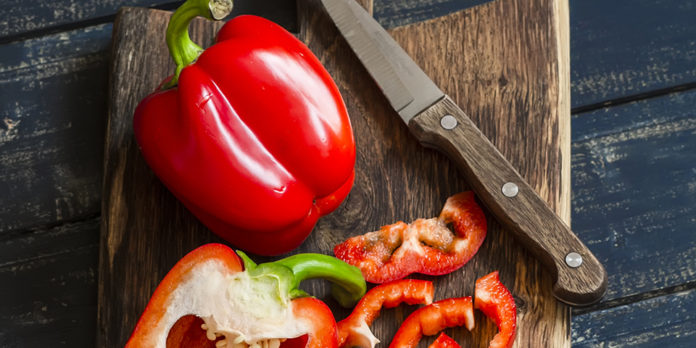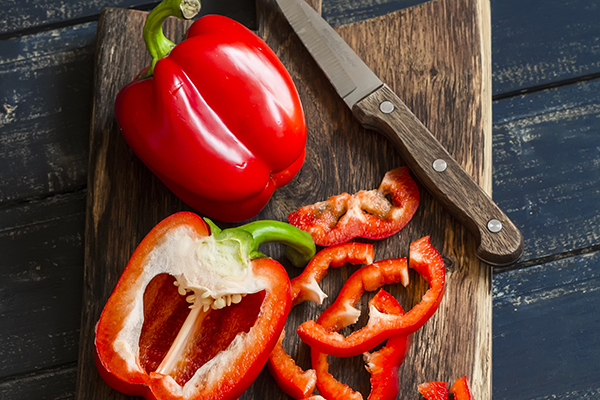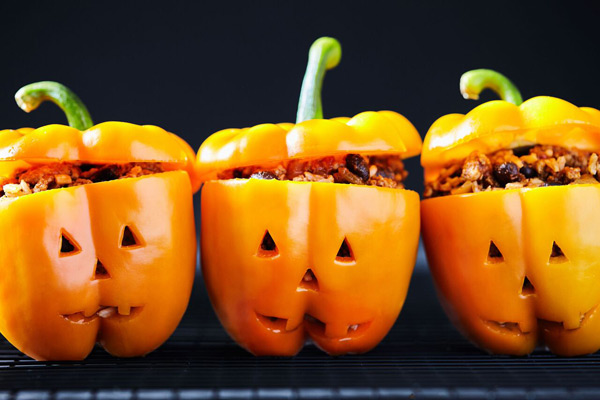Bell peppers are crispy, crunchy, and mildly sweet.
They’re popular in low-carb cooking, and you can find them year-round at your local grocery store (although they taste best when they’re in season during the summer and fall!). But are bell peppers good for you? Yes!
Let’s go over some of the health benefits of bell peppers and how you can cook with them in tasty, low-carb-friendly recipes.
Bell peppers are low in calories and carbs
A large, whole bell pepper contains just 43 calories and 10 grams of carbs, which is probably welcome news for those who want to lose weight.
So, do bell peppers make you gain weight? In all likelihood…no!
You’re better off looking for other culprits in your diet.
Any food in excess can cause weight gain, but the likelihood of eating more than three bell peppers in a sitting is rare (~129 kcals), which is around the typical serving of potato chips.
And when it comes to salty snacks like chips, you’re more likely to eat more than one serving.
Bell peppers are high in nutrients
Make no mistake — bell peppers may be low in calories, but they’re packed with nutrients.
They contain vitamin A, C, B6, and folate, as well as potassium and iron. So, which color bell pepper is the healthiest?
According to Brittany Crump, M.P.H., R.D. at Savor Nutrition, “In the case of nutrients, the color of your bell peppers does make a difference.”
Green bell peppers are picked before they ripen to red. A green pepper already contains 150% of your daily recommended needs for vitamin C.
A red pepper can offer 350% of your daily recommended needs.
Let’s dig a little deeper:
- The recommended daily allowance of vitamin C for females is 75 mg per day.
- For men, it’s 90 mg per day.
- Any type of large bell pepper contains 128 mg of vitamin C. So for women, that’s 171% of the RDA and, for men, it’s 142%.
“Red, yellow, and orange bell peppers are higher in lycopene and carotenoids than immature green peppers,” says Crump.
Carotenoids are plant-based antioxidant-like compounds that may help protect your cells from the damage of oxidation.
Bell peppers are a good source of fiber
Bell peppers contain a good amount of fiber compared to the number of calories they add to your diet.
Eating a large, whole pepper will give you 3.5 grams of fiber, which is 14% and 9% of the daily recommended amount for women and men, respectively.
Eating enough fiber is especially important for weight loss and overall wellness because it helps make you feel fuller for longer and keeps you regular by preventing constipation.
Bell peppers are mild and easy to eat
Why choose bell peppers over all the others?
Crump explains, “Bell peppers are mild and a good option if you prefer to avoid spicy peppers. For those with heartburn, bell peppers are a good substitute for spicy peppers, which can worsen heartburn.”
Unlike chili peppers, bell peppers do not contain capsaicin, the substance that gives peppers their burn.
3 Easy Ways to Cook Bell Peppers
Now that the question, “Are bell peppers good for you?” has been answered, let’s discuss how to cook with them.
No doubt, you can enjoy bell peppers fresh and sliced into snack sticks, but why not get a little more creative in the kitchen?
1. Stuffed or loaded bell peppers
Stuffed bell peppers can be a great way to reuse leftovers. The hollow cavity of bell peppers is made for stuffing with ground meats, egg, cheese, beans, rice, or other cooked veggies.
Of course, you can also just load these same ingredients over sliced bell peppers and bake.
Get creative — it’s all in how you want to slice your bell peppers. Some recipes for inspiration:
2. Grilled or roasted bell peppers
Caramelize the sugars in bell peppers to get even more flavor out of your veggies. You can achieve this on a grill (smoky) or in the oven (charred).
- To grill a bell pepper, cut it into quarters, coat it with nonstick cooking spray, and place them directly on the grill grate for 5-10 minutes.
- To roast bell pepper, cut it into quarters, coat with nonstick cooking spray, season, and bake at 450 degrees F for 15-20 minutes.
Enjoy as-is, or use cooked bell peppers as an ingredient in another dish such as:
3. Stir-fried bell peppers
Let’s face it — bell peppers are key in making any meat and veggie stir-fry dish beautiful to look at as well as making it even more delicious.
They add a pop of red, yellow, or orange to an otherwise sea of greens and browns.
Stir-fries are an easy, healthy dinner option:
Looking for more expert nutrition information? Head over to BODNutrition.com and learn how to eat healthy with the help of our two nutrition programs, 2B Mindset and Portion Fix.




























